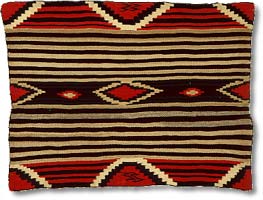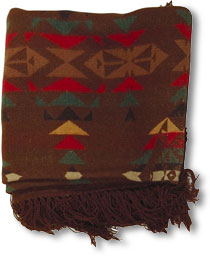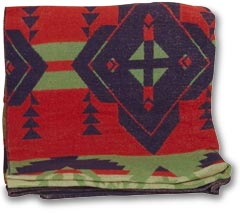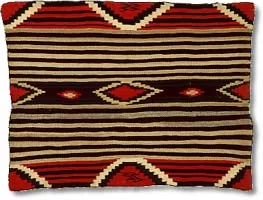Native American blankets are a significant and culturally rich aspect of Native American art and heritage. These blankets are often handmade and reflect the artistic traditions, symbols, and designs of various Indigenous tribes across North America.
The three most common styles of the highly collectible Native American blankets are: Navajo wearing blankets, Pendleton trade blankets, and Beacon cotton blankets.
Navajo wearing blankets


Handmade by Navajo women on upright looms, Navajo blankets can take a year to complete. Pieces from the Classic Period (1850-1875), woven for personal use, made skilful use of available dyes and sheep’s wool. A striped chief’s blanket from this era is worth in the six figures.
Navajo blanket c. 1868
After the Navajo were sent to a reservation, the Transitional Period (1875-1890) saw yarns supplied by traders, especially brightly-colored yarns from Germantown, Pennsylvania. Many of these pieces were produced for sale (originally $5.00-$20.00).
Navajo weavings after 1890, produced primarily for the tourist trade, vary significantly in quality — some current weavers are highly sought after.
Pendleton blankets


Around 1896, Pendleton Woolen Mills began making machine-made wool blankets with Indian designs, produced for sale to traders on reservations.
These brightly colored blankets, prized by both Native Americans and Anglos, became known as trade blankets. Trade blankets are categorized as “shawls” (with fringe, for women) or “blankets” (without fringe, for men).
Pendleton blanket with fringe c. 1920s
Pendleton Woolen Mills, a company founded in 1863, has a long history of producing Native American-inspired blankets. They work in collaboration with Native American artists to create designs that pay homage to various tribes.
Beacon Blanket Company
From 1910 through the 1950s, the Beacon Blanket Company of Massachusetts produced machine-made cotton blankets with Indian patterns. Intended for camping and picnics, they became known as camp blankets. The colors of these washable blankets have held up remarkably over the years. Some later art deco patterns are often grouped in with the Indian patterns.


Beacon blanket c. 1920s
Old blankets have memories and the uniquely American Indian blanket invokes our romance with the old west.
Here are some points from an expert to consider when collecting Indian blankets:
Authentic Native American blankets
Handmade Navajo weavings exhibit natural variations in the yarn and dye. They are unsigned. At the end of a piece, a Navajo woman will weave in an imperfection (such as a piece of mismatched yarn) to allow her soul to escape from the weaving and go on to another.
Though Beacons (cotton) and Pendletons (uniform, machine-made wool) had labels, many were lost over time. Learn to trust your eyes and hands. A lot of shabby copies came out in the early ’80s, with threads so far apart they resemble rows of corn.
Watch for Mexican weavings done in the Navajo style; while some are woven by Mexican Indians, and most are labeled accurately, they are not authentic Navajo.
Condition of vintage Native American blankets
Condition of vintage blankets is of less concern than with many collectibles. It depends on the pattern.
A common pattern with many holes won’t be worth much. But old, scarce patterns with damage can bring high prices.
Think of them as folk art. Folk art was never perfect.
Blankets were made to be used: drape them over a couch or table, make a stack of them. I use the camp and trade blankets like any blanket; people put Navajo blankets on the walls or floor.
Availability
You can still spot vintage Indian blankets in flea markets and antique malls at good prices. When investing in a quality blanket, buy from a reputable dealer.
You can visit Arizona’s Navajo trading posts. Some galleries, especially those specializing in folk and Native American art, deal in Indian blankets.
All of these blankets are still being made today, and new blankets are also collectible (Beacon is now located in North Carolina).
Care for Native American blankets
Dry clean Pendleton blankets.
Machine wash Beacon blankets using the gentle cycle with cold water; air dry. Do not dry clean Beacons.
For Navajo blankets, find a dry cleaner familiar with Navajo dyes.
Also in this feature series: What to look for in Antique Native American Jewelry Navajo & other Native American artists used silver, turquoise, coral, & other materials to create unique and intricate pieces.
In the 18th and 19th centuries, European traders introduced trade blankets to Native American communities. These blankets became an important part of trade and commerce and often featured distinct designs. Hudson’s Bay Company blankets are a well-known example.
Native American blankets are not only functional but also hold deep cultural and artistic significance. They continue to be a source of pride and identity for Indigenous communities and a way to celebrate and share their rich heritage with the world.
Further Reading:
The Four Winds Guide to Indian Trade Goods & Replicas: Including Stone Relics, Beads, Photographs, Indian Wars, and Frontier Goods – by Preston Miller
Field Guide to Flint Arrowheads & Knives of the North American Indian: Identification & Values by Lawrence Tully, et al
Rifles, Blankets, and Beads:
Identity, History, and the Northern Athapaskan Potlatch by William Simeone
Weaving a Navajo Blanket by Gladys Amanda Reichard
A Guide to Navajo Weavings by Kent McManis, Robert Jeffries
Navajo Textiles : The William Randolph Hearst Collection by Nancy Blomberg
Pendleton Woolen Mills by Pendleton
The Chief’s Blanket by Michael Chanin, Kim Howard
Language of the Robe: American Indian Trade Blankets by Robert Kapoun, Charles Lohrmann
Navajo Weaving Way: The Path from Fleece to Rug by Noel Bennett
Indian Basket Weaving by Navajo School of Indian Basketry
Navaho Weaving: Its Technic and History by Charles Avery Amsden
Deerskins & Duffels: The Creek Indian Trade With Anglo-America, 1685-1815 by Kathryn Holland Braund
The Cheyenne in Plains Indian Trade Relations 1795-1840 by Joseph Jablow, Morris Foster
Under Sacred Ground: A History of Navajo Oil, 1922-1982 by Kathleen Chamberlain
Chiefs & Chief Traders: Indian Relations at Fort Nez Perces, 1818-1855 by Theodore Stern
White Man’s Wicked Water: The Alcohol Trade and Prohibition in Indian Country, 1802-1892 by William Unrau
Indian Trade Goods by Arthur Woodward




